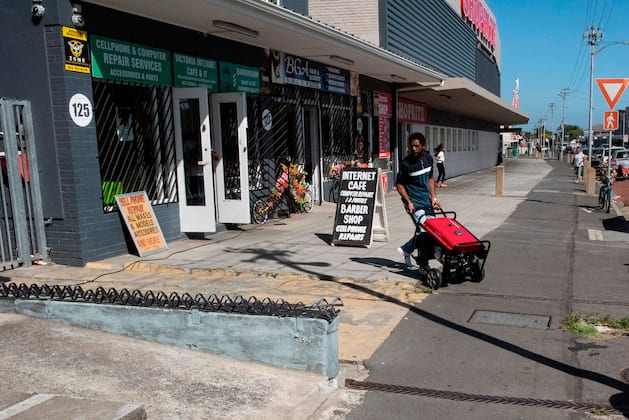It’s still new in Germany: the fear of a blackout. In South Africa daily power cuts have been part of everyday life for years – and cause considerable damage.
No electricity for several hours a day? And that for weeks or even months? Until recently, such a scenario was almost unimaginable in Germany. But ever since the Russian war of aggression in Ukraine endangered Germany’s energy supply, many people in Germany have been concerned about the risk of power failures.
In South Africa, large-scale power failures have been a reality for a good 15 years. In January, 60 million South Africans had to go without electricity for up to ten hours a day. During the so-called “load shedding” (load disconnection), the state-owned energy producer Eskom shuts down the electricity for several hours in order to save capacity and avoid a complete blackout. The group, which is responsible for 95 percent of the electricity supply, has been accused of corruption and mismanagement. Eskom is highly indebted at a good 21 billion euros. Its power plants and infrastructure are outdated and poorly maintained.
Last year there were power outages in South Africa on 205 days. In comparison, according to government statistics, households in Germany had to go without electricity for an average of 10.73 minutes throughout the year in 2020. Pretty much every South African has an app on their phone that shows when and where the next load shedding will take place. This schedule determines when to cook, do laundry, blow-dry your hair, or charge electronic devices.
Household appliances break down more quickly due to the constant switching on and off. Failed traffic lights lead to traffic chaos and traffic jams. Citizens’ registration offices close the doors early. According to the police, the number of burglaries and robberies increases when entire neighborhoods are in darkness at night. School children have to do their homework by candlelight. ATMs are out of service. “Closed for Loadshedding” is a sign that regularly hangs in store windows.
According to economist Hugo Pienaar, every hour without electricity costs South Africa’s economy up to 27 million euros. Small and medium-sized companies that cannot afford generators, battery-operated inverters or solar systems are particularly threatened. In small shops, products thaw or spoil faster. Gas stations cannot dispense petrol. Restaurants have to turn away guests. In carpentry workshops, the machines stand still for hours.
Farmer Herman du Preez suffocated more than 40,000 chickens in one night in the north-western town of Coligny. Blackouts and low voltages have damaged computerized temperature control and ventilation systems, Du Preez says. He wants to sue Eskom for damages equivalent to 100,000 euros. In general, the losses in the agricultural sector are enormous, says Mariaan Hendriks, representative of a farmers’ association in the North West Province, in a letter of complaint to Eskom: “Loadshedding is the biggest cause of food insecurity, rising food prices, job losses and the slowdown of our economy.”
The mobile network operator Vodacom said it had to invest around 54 billion euros a year in batteries to keep the mobile network running during power cuts. The more than 600 German companies that, according to the Federal Foreign Office, have invested more than 5.3 billion euros in South Africa – including VW, Daimler, Bayer, Siemens and the Schenker shipping company – are also feeling the effects of the energy crisis.
Even Eskom has to resort to diesel generators to avoid a system collapse. According to the electricity supplier, it burns millions of liters of diesel during load shedding, which cost it around one billion euros in 2022. Eskom now wants to help finance this with rising electricity prices.
Worse than the financial losses, the energy crisis is costing lives. Already ill-equipped public hospitals are sometimes unable to perform emergency surgeries when the electricity is gone, Professor Adam Mohamed, senior physician in internal medicine at Charlotte Maxeke Hospital in Johannesburg, writes in a petition. The periods between “loadshedding” blocks are too short to recharge batteries in neonatal and intensive care units. This is “deadly for infants and the most vulnerable patients,” said Mohamed. Mohamed complains that the water supply, which has been impaired due to power cuts, has led to poor hygiene and the spread of infections.
South Africans are outraged by government priorities. Because in streets where ministers live, the electricity is not switched off for safety reasons.
There is no quick fix to South Africa’s electricity crisis. Eskom recently admitted that loadshedding is likely to continue for another two years. Only now is the government ready to soften Eskom’s quasi-monopoly. In general, President Cyril Ramaphosa promised in January that more private energy producers would be permitted and a good hundred private power plants would be connected to the national electricity grid by the end of the year. For the first time, South Africans will be able to sell surplus electricity from solar modules to Eskom and feed it into the national grid.
But implementing such plans will take months, if not years. Until then, South Africans will be in the dark.
Electric cars and heat pumps are crucial building blocks for the energy transition. But if everyone uses them, the power grid collapses. That’s why electricity suppliers should be allowed to throttle the juice from time to time. Companies like Tesla and Viessmann think that’s a really bad idea.
From March 1st, millions of households can benefit from the gas price brake and district heating brake. At the same time, the federal states are starting to reimburse the additional costs for heating oil, pellets and liquid gas from 2022. FOCUS online says how tenants make payments and what applies to you.















